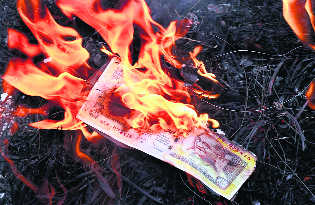
Demonetisation led to a loss of Rs 2.25 lakh crore .
Pritam Singh
Demonetisation, hyped as an economic policy of 'surgical strike' against black money and terrorism, can be viewed with hindsight as more of 'carpet bombing' on Indian people especially those in the informal economy.
Demonetisation was paraded as a big leap towards creating a cashless economy in India. The work of Prof Barbara Harriss-White of Oxford University and of the late Arjun Sengupta had conclusively demonstrated that the informal sector, dependent on cash transactions, constituted the overwhelming sector of the Indian economy. As this research was well known in economic policy circles, the demonetisation move indicated both its flawed nature as an instrument of economic management as well as aloofness, or even perhaps contempt, for ordinary working people of the country.
The constant references to demonetisation as an economical 'surgical strike' akin to the Indian military's 'surgical strike' against a neighbouring country and terrorism of a certain brand also revealed a thinly disguised political attempt to seek approval for the move by invoking majoritarian communal and sectarian sentiments.
The hollowness of the claim that this move was aimed at curbing black money becomes clear from a report 'Measures to tackle black money' produced by the Central Board of Direct Taxes in 2012. This report, in an understated way, argued that demonetisation might not be a solution for tackling black money or economy because black money is held largely in the form of benami properties, bullion and jewellery. Income tax investigations showed that black money holders kept only six per cent or less of their wealth as cash. Targeting this cash as a central component of anti-black money strategy is plainly ridiculous if not criminal negligence.
This raises the question: why did the BJP-led government launch this policy? What were its political motives as no economic policy anywhere in the world is without political motives of the ruling party. The answer lies in understanding the close ties between BJP and the big business, and the party's social-electoral base. It has been reported in media that the Indian banking sector was bedevilled with large loan defaults by top corporates . Consequently, the banks, especially public sector ones, were virtually starved of funds to lend and thus creating a condition of credit crunch. The BJP's big business ties meant that it could not hit the large corporate defaulters to recover the loans but it needed banks to have sufficient funds to lend to its social-electoral base in the small and medium trading communities.
Demonetisation was viewed as a way of recapitalising the banks to ensure sufficient lending to BJP's socio-electoral base but without hitting the ruling party's corporate friends.
Demonetisation has failed in meeting its stated objective of attacking black economy cash as well as in its consequences for the Indian economy. A recent RBI annual report revealed low efficacy of demonetisation. It pointed out that of the Rs 15.44 lakh crore taken out of circulation, Rs 15.28 lakh crore had returned to the system by way of public deposits. Most of this was already 'white' coming out of the earnings of millions of ordinary households and if there were black money holders, they have made it 'white' now.
Its consequences have been devastating for certain social groups who are not normally BJP's vote bank. Farmers and informal sector workers such as weavers, embroiderers, tailors and crafts persons in the textile/apparel activities were particularly hit hard. Industrial production has also suffered. According to one estimate, demonetisation had led to a loss of GDP of Rs 2.25 lakh crore.
Overall, it was a badly designed policy with sectarian political objectives. It had negligible gains, if any, but huge losses in the form of cost of printing new notes, adverse impacts on agriculture, industry and GDP; destruction of many livelihoods and causing many deaths.
— The writer is Professor of Economics, Oxford Brookes Business School, Oxford



























